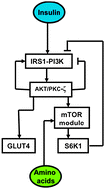Quantification of the effect of amino acids on an integrated mTOR and insulin signaling pathway†
Abstract
Integration of

* Corresponding authors
a School of Biosciences and Bioengineering, Indian Institute of Technology, Bombay, Powai, Mumbai-400 076, India
b
Department of Chemical Engineering, Biosystems Engineering Lab, Indian Institute of Technology, Bombay, Powai, Mumbai-400 076, India
E-mail:
venks@che.iitb.ac.in
Fax: +91 22 25723480
Tel: +91 22 25767223
Integration of

 Please wait while we load your content...
Something went wrong. Try again?
Please wait while we load your content...
Something went wrong. Try again?
P. K. U. Vinod and K. V. Venkatesh, Mol. BioSyst., 2009, 5, 1163 DOI: 10.1039/B816965A
To request permission to reproduce material from this article, please go to the Copyright Clearance Center request page.
If you are an author contributing to an RSC publication, you do not need to request permission provided correct acknowledgement is given.
If you are the author of this article, you do not need to request permission to reproduce figures and diagrams provided correct acknowledgement is given. If you want to reproduce the whole article in a third-party publication (excluding your thesis/dissertation for which permission is not required) please go to the Copyright Clearance Center request page.
Read more about how to correctly acknowledge RSC content.
 Fetching data from CrossRef.
Fetching data from CrossRef.
This may take some time to load.
Loading related content
